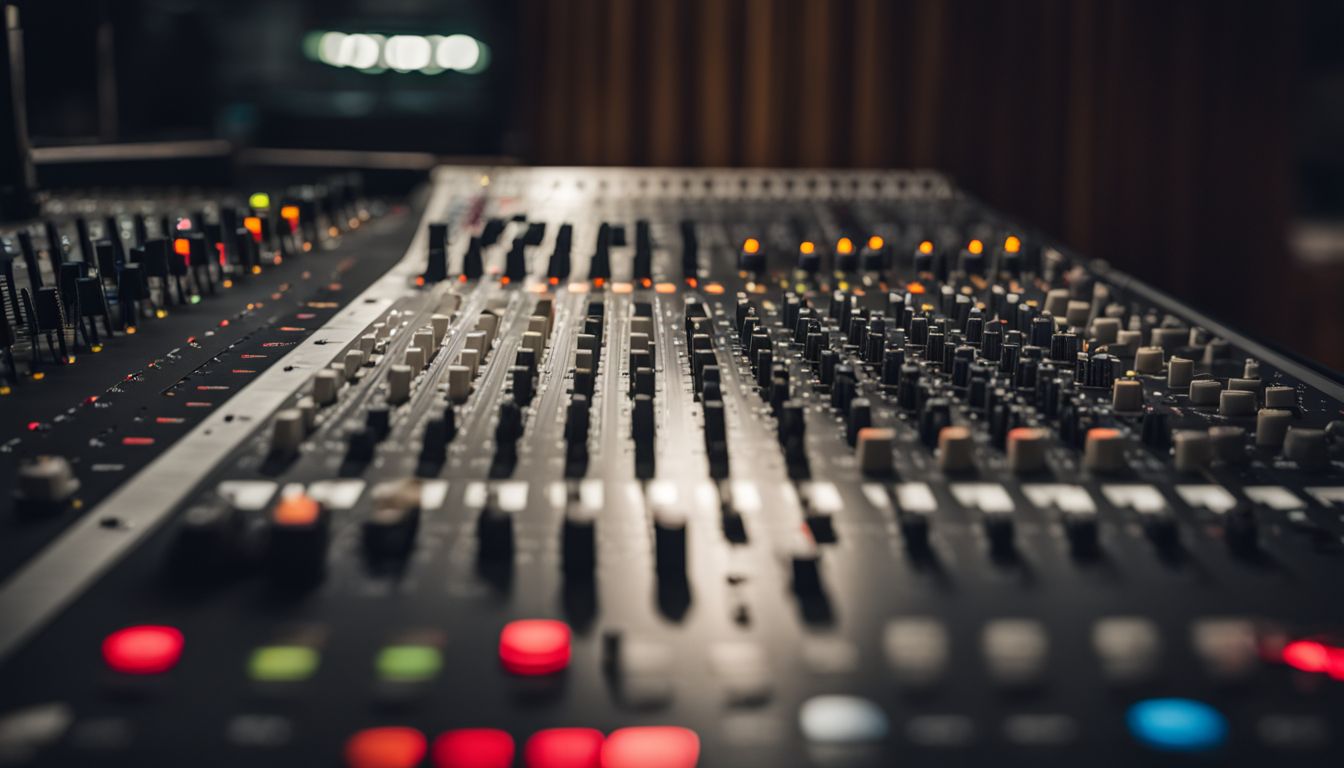Have you ever been listening to a song and noticed how it gently starts to play, as if the volume is being turned up slowly? That’s what we call a “fade in” in music. It’s a technique that artists and producers use to draw listeners into their sonic world smoothly.
This article will guide you through the ins and outs of fade-ins and fade-outs, making these audio effects easy to understand and apply. Are you ready for an audio adventure? Keep reading!
Key Takeaways
- Artists like The Beatles have effectively used the fade in music technique to gradually introduce songs by increasing the volume, often creating an inviting start. Artists like The Beatles have used this method effectively in their tracks.
- Faders on audio mixers are tools that allow for smooth transitions between songs or within an audio track; crossfading can blend two songs seamlessly, which is particularly useful for DJs during live sets and editors in post-production.
- Software such as MiniTool Movie Maker for Windows and iMovie for MacOS makes it easy to apply fade-ins and fade-outs to your audio projects, enhancing the listening experience with professional-sounding effects.
- Understanding pre-fader and post-fader settings helps sound engineers control how effects like reverb respond to volume changes during live performances or recording sessions.
- Fade-outs not only serve as a way to end a track smoothly but also help listeners transition emotionally from one piece of music to the next, adding depth and contemplation to the auditory experience.
Understanding the Concept of Fade in Music
Diving into the world of music production, the subtle art of fading in offers a window into the craftsmanship behind your favorite tunes. It’s a technique as old as recorded sound itself, shaping the auditory experience by giving tracks either an unassuming entrance or a gradual exit.
Origins and early examples
The decline in technique in music is far from a modern invention. It’s a method that dates back to the earliest days of recording, subtly introducing listeners to a song by slowly ramping up the volume.
Think about iconic tracks like The Beatles’ “Eight Days a Week,” with its gradual welcome into an upbeat melody, or Bill Haley’s energetic rendition of “Rocket 88.” Both are stellar early examples of this sound engineering technique.
Many historians credit Paul Anka’s hit “Diana” as one of the first instances in pop music production where a fade was used, marking the beginning of an industry-wide trend.
Before these hits made their mark, discs and phonograph records with fading audio were already shaping how audiences experienced music. This easily overlooked aspect has transformed storytelling through songs, ushering in new artistic possibilities for musicians and audio engineers alike.
Fader and Crossfading
Faders on a mixing board allow audio engineers to smoothly increase or decrease volume, shaping the dynamics of an audio track. Imagine a DJ at a club seamlessly transitioning from one song to another without jarring interruptions; that’s crossfading in action.
Crossfading involves careful timing and balancing levels as one track fades out and another fades in, creating an uninterrupted flow of music. It’s not just for live performances—editors often use this technique during post-production to blend scenes or introduce new elements into a mix.
Essential for crafting polished transitions in any audio project, manual mixing enables precision control over fading effects. DJs employ crossfaders on their mixers to achieve beatmatching—a skill where they align the beats of two songs for a flawless merge.
In sample editing, even a minor error during the crossfade can ruin the seamless loop that producers want. With each gentle slide of the fader or nuanced adjustment on digital software like Premiere Pro or iMovie, creators forge engaging soundscapes ready for listeners’ ears, and our next discussion explores how exactly these fading techniques are put into practice across different platforms.
How to Fade in and Fade Out Music?
Mastering the art of fading music in and out can elevate your audio projects from amateur to professional with just a few clicks or taps. Whether you’re on a PC or Mac, modern software simplifies this process, allowing you to seamlessly blend tracks or signal transitions without needing an advanced degree in audio engineering.
In Windows
Fading in your music on a Windows computer enhances the listening experience by smoothing out audio transitions. MiniTool Movie Maker provides a straightforward solution for achieving this effect with ease.
- Download and install MiniTool Movie Maker from its official website.
- Open the program and import your audio file by dragging it into the media library.
- Drag the imported audio clip onto the timeline at the bottom of the screen.
- Click on your audio file to select it, then find the “Edit” button above the timeline.
- In the editing panel, locate the “Fade in” option and choose how long you want the fade effect to last.
- Preview your selection by hitting the space bar; adjust as needed until satisfied with how it sounds.
- Save your project and export your newly edited audio clip with the fade-in effect applied.
In MacOS
Mac users have a powerful tool at their fingertips with iMovie, which allows them to manipulate audio in various ways. Fading in music can add a professional touch to your projects, and here’s how to do it using iMovie on MacOS:
- Open your iMovie project and locate the audio clip you want to fade in.
- Click on the clip to select it, revealing its properties in the video timeline at the bottom of the screen.
- Look for a line with small dots or “handles” on it; that’s your clip’s volume control.
- Hover your cursor over the handle at the beginning of your audio waveform; this is where you’ll begin creating your fade-in effect.
- Drag this handle to the right slowly; as you drag, you’ll see the volume line gradually ascend from silent to its full volume, creating a gentle fade-in.
- Listen closely by pressing ‘play’ on your project; adjust the duration of the fade by dragging more or less of the waveform for a perfect blend.
- Make finer adjustments by clicking on that same handle and using the left or right arrow keys for precise control over your fade-in curve.
The Role of Fades in Audio Editing
In audio editing, mastering the use of fades is akin to an artist perfecting brush strokes; it’s a subtle yet powerful tool that can transform the dynamics of a track. Whether you’re a seasoned sound engineer or just starting out with your first mix, understanding the role of fades will elevate the polish and fluidity of your final audio product.
Gradual increase or decrease in volume
Fades in music aren’t just for show; they play a crucial role in audio transitions. A fade-in gently brings a sound into the mix, allowing it to emerge from silence with grace. This technique is particularly useful for smoothing out vocals that start too abruptly, which might otherwise jar the listener’s ear.
On the other hand, fading out can expertly cloak the end of a track that doesn’t have a clear-cut conclusion, letting it disappear into silence without any awkwardness.
Using fades effectively requires skillful manipulation of volume controls, either through an audio editor or a DJ mixer. Crossfading steps up the game by blending two tracks together seamlessly.
Imagine one song on an album leading right into the next without missing a beat—this is cross-faded magic at work. Both manually and via software tools, DJs and producers use these techniques to create immersive listening experiences that keep you hooked from start to finish.
Pre-fader, post-fader
In the world of audio engineering, understanding the distinction between pre-fader and post-fader is vital for achieving the desired sound mix. Pre-fader signals allow you to send an untouched version of the audio to a separate output, like an auxiliary send, which means this signal won’t change even if you adjust the main channel strip fader.
This feature proves useful when certain parts of a live performance or recording session require different routing from the main mix.
On the other hand, adjustments made to their corresponding channel strip faders directly affect post-fader sends. If you’re fading out audio using a post-fader send, any adjustments to that channel’s volume will affect what is sent through that path as well.
Therefore, this setup is commonly used when effects such as reverb need to follow the volume movements of each track in harmony with front-of-house mixes or final master tracks for production consistency.
Practical Applications of Fades in Music
The art of the fade isn’t just for show; it’s a versatile tool that shapes how we experience music, whether melding tracks together seamlessly or signaling a song’s end with subtlety.
Its adept use can evoke emotions, craft narrative pauses, and even serve as an audible cue in live performances—fades are genuinely the unsung heroes of audio engineering.
Fading between songs
Fading between songs is like the magic glue that binds tracks together into a cohesive musical journey. It smooths the transition from one tune to another, ensuring that there’s no awkward silence or jarring jump in tempo or mood.
Picture yourself walking through Harbour City; each shop flows into the next without stark contrasts, creating an enjoyable shopping experience. That’s what fading does for music.
DJs have mastered this art, letting beats blend by adjusting faders on their mixers during live sets—it’s audio engineering with a dash of rhythm.
Crafting a playlist for an event? Consider how crossfades can maintain the energy level throughout your setlist, much like seamlessly connecting Canton Road and Tsim Sha Tsui with harmonious city vibes.
Music producers harness fade-outs to signal listeners that it’s time to expect something new, building anticipation as one song gradually dissolves into another. This technique prevents abrupt stops and starts, polishing the overall listening experience, whether you’re enjoying tunes through headphones or rocking out in front of the house at a concert.
The meaning of fade-out music
Transitioning smoothly from one song to another often involves fading techniques, but what happens when the track itself needs a smooth exit? This is where the fade-out comes in as an artistic and practical tool.
A fade-out gradually lowers the volume of a track until it becomes inaudible, providing an effective way for artists to conclude a piece without an abrupt stop. In audio engineering, executing a flawless fadeout can transform a simple ending into an immersive experience that leaves listeners yearning for more.
This subtle technique has solved ending dilemmas for countless songs, especially those without clear-cut conclusions. It allows music producers to weave soundscapes that gently taper off, often evoking emotions or contemplation as the audio signal fades to silence.
Implementing fade-outs can also aid in blending dialogue with background scores in documentaries or voice-overs, ensuring neither overshadows the other. Furthermore, this gradual decline of sound not only serves as an ending but also invites reflection on what was heard or anticipation of what’s to come—without the need for any spoken words.
Conclusion
Fades in music aren’t just technical tweaks; they breathe life into audio, shaping how we experience melodies and messages. Mastering the art of fading paves the way for smooth transitions that can touch emotions subtly or sweep listeners off their feet.
Whether creating compelling tracks on a Microsoft Surface with an RTX 2060 graphics card or blending beats for a documentary in Tsim Sha Tsui, Kowloon, fades play a crucial role. Embrace these techniques to seamlessly guide your audience through auditory journeys.
With tools like Adobe Premiere Pro CC and iMovie at your fingertips, crafting perfect fade-ins and fade-outs is within reach for any aspiring audio engineer or video editor.
Discover another intriguing aspect of music by exploring what washboard music entails and its unique sound.
FAQs
What does ‘fade in’ mean in music?
In audio engineering, fade-in is a technique where the volume of a song gradually increases from silence to its original level, creating a smooth introduction to the track.
Can you use fade-in effects on all types of audio files?
Yes, whether it’s an MP3, AAC, or even CD, you can apply the fade-in effect using various audio tools and software.
Is fading only used at the beginning of songs?
No, fading can be used both at the start and end of tracks; when it’s used at the end, it’s called a ‘fade-out.’
Can I add fade-ins to my videos myself?
Absolutely! With video editor programs available for computers like those with an RTX 2060 graphics card or Microsoft Surface devices with iGPU technology, you can easily add fade-ins to your documentary or other projects.
Do DJs use fades only for transitioning between songs?
DJs often use fades, such as beatmixing and scratching techniques, not just for transitions but also to enhance live performances and create dynamic musical experiences.


